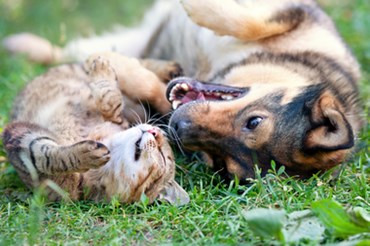Spinal Surgery For Dogs And Cats

At Hope Springs, our talented veterinary doctors specialize in providing a wide range of options in performing spinal surgery for dogs and cats. Your pet is in careful hands with our experienced and knowledgeable team of veterinary surgeons. As with all of our surgical procedures, we make comfort and safety our priorities before, during and after your pet's procedure.
Should your pet be experiencing a back, or spinal injury, our veterinary doctors will conduct an initial consultation prior to taking any steps toward medical or surgical treatment options. In assessing your pet's specific medical needs, we perform a range of diagnostic testing, including radiographs, to most accurately determine a positive treatment plan.
Your pet's procedure will take place in our state of the art, comfortable and secure hospital environment, and will typically require overnight stay. Following spinal surgery, our veterinary doctors will determine an effective rehabilitation and recovery program to ensure a safe and successful outcome for your pet.
Your pet's spinal health is the basis of your pet's quality of life, comfort and active lifestyle. The back bone (spine) is made up of multiple smaller bones called vertebrae, and in between each one of these vertebrae are disks. These disks act as cushion pads between each one of the vertebrae. There are a couple of diseases that cause the disk material to be painfully pushed up towards the spinal cord. Oftentimes, these pets can be managed medically, avoiding invasive surgical interventions. When surgery is indicated, it is imperative that it be done as soon as possible to prevent permanent loss of function to the affected region of the body.
Once it is clear that the patient has disk disease, and the patient needs surgery to decompress the spinal cord, the veterinarian will decide which of the following styles of spinal surgery for dogs and cats to provide:
- Hemilaminectomy: This procedure is usually performed in the thoracolumbar region. In this surgery, the articular facets (where the two vertebrae connect) are removed, in addition to the bone adjacent to the spinal cord. This can safely be performed on up to 5 disc spaces.
- Pediculectomy: This procedure is similar to the hemilaminectomy in that the articular facets are not removed. This approach is used when the disk herniation is off to the side rather than directly upward. This procedure is less invasive than a hemilaminectomy.
- Dorsal Laminectomy: This procedure is the most invasive of all procedures, and involves decompressing the spinal cord from the top rather than from the bottom. It can be done only over one disk space, and involves removing the dorsal spinous process and lamina.
- Ventral Slot: This procedure is reserved for disk herniation in the neck. Here, the slot is drilled in the vertebral bodies of the bones on either side of the disk creating a small window over the disk space on the underside (ventral portion) of the vertebral bodies. Mineralized disk material can be removed and, since the window includes adjacent bone, there is room for the swollen spinal cord to decompress.
- Fenestration: This is a preventative procedure often performed on the disk spaces near the herniated disk space. It involves creating a window over the annulus fibrosis (the covering of the disk) and removal of any mineralized nucleus pulposis (soft center of the disk material). For some patients, this is the only surgery needed but it is not truly a decompressive surgery.
We want to help you stay well informed about preventive pet health care. Explore our pet health resources and advice below to learn more.










